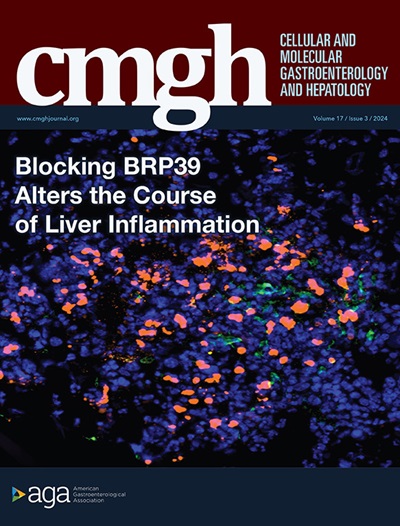Deriving Human Intestinal Organoids with Functional Tissue-Resident Macrophages All From Pluripotent Stem Cells
IF 7.1
1区 医学
Q1 GASTROENTEROLOGY & HEPATOLOGY
Cellular and Molecular Gastroenterology and Hepatology
Pub Date : 2025-01-01
DOI:10.1016/j.jcmgh.2024.101444
引用次数: 0
Abstract
Background & Aims
Organs of the gastrointestinal tract contain tissue-resident immune cells that function during tissue development, homeostasis, and disease. However, most published human organoid model systems lack resident immune cells, thus limiting their potential as disease avatars. For example, human intestinal organoids (HIOs) derived from pluripotent stem cells contain epithelial and various mesenchymal cell types but lack immune cells. In this study, we aimed to develop an HIO model with functional tissue-resident macrophages.
Methods
HIOs and macrophages were generated separately through the directed differentiation of human pluripotent stem cells and combined in vitro. Following 2 weeks of coculture, the organoids were used for transcriptional profiling, functional analysis of macrophages, or transplanted into immunocompromised mice and matured in vivo for an additional 10–12 weeks.
Results
Macrophages were incorporated into developing HIOs and persisted for 2 weeks in vitro HIOs and for at least 12 weeks in HIOs in vivo. These cocultured macrophages had a transcriptional signature that resembled those in the human fetal intestine, indicating that they were acquiring the features of tissue-resident macrophages. HIO macrophages could phagocytose bacteria and produced inflammatory cytokines in response to proinflammatory signals, such as lipopolysaccharide, which could be reversed with interleukin-10.
Conclusions
We generated an HIO system containing functional tissue-resident macrophages for an extended period. This new organoid system can be used to investigate the molecular mechanisms involved in inflammatory bowel disease.
用功能性组织驻留巨噬细胞从多能干细胞中获得人肠道类器官。
背景与目的:胃肠道器官包含组织驻留免疫细胞,在组织发育、体内平衡和疾病过程中发挥作用。然而,大多数已发表的人类类器官模型系统缺乏常驻免疫细胞,因此限制了它们作为疾病化身的潜力。例如,来自多能干细胞的人类肠道类器官(HIOs)含有上皮细胞和各种间充质细胞类型,但缺乏免疫细胞。在这项研究中,我们的目的是建立一个具有功能的组织驻留巨噬细胞的HIO模型。方法:通过人多能干细胞定向分化分别生成HIOs和巨噬细胞,并在体外结合。共培养两周后,类器官用于转录谱分析、巨噬细胞功能分析,或移植到免疫功能低下的小鼠体内,并在体内成熟10-12周。结果:巨噬细胞被纳入正在形成的HIOs,并在体外HIOs中持续2周,在体内HIOs中持续至少12周。这些共培养的巨噬细胞具有类似于人胎儿肠的转录特征,表明它们正在获得组织内巨噬细胞的特征。HIO巨噬细胞对脂多糖等促炎信号能够吞噬细菌,产生炎性细胞因子,IL-10可以逆转这一过程。结论:我们产生了一个长时间含有功能性组织巨噬细胞的HIO系统。这种新的类器官系统可用于研究炎症性肠病的分子机制。
本文章由计算机程序翻译,如有差异,请以英文原文为准。
求助全文
约1分钟内获得全文
求助全文
来源期刊

Cellular and Molecular Gastroenterology and Hepatology
Medicine-Gastroenterology
CiteScore
13.00
自引率
2.80%
发文量
246
审稿时长
42 days
期刊介绍:
"Cell and Molecular Gastroenterology and Hepatology (CMGH)" is a journal dedicated to advancing the understanding of digestive biology through impactful research that spans the spectrum of normal gastrointestinal, hepatic, and pancreatic functions, as well as their pathologies. The journal's mission is to publish high-quality, hypothesis-driven studies that offer mechanistic novelty and are methodologically robust, covering a wide range of themes in gastroenterology, hepatology, and pancreatology.
CMGH reports on the latest scientific advances in cell biology, immunology, physiology, microbiology, genetics, and neurobiology related to gastrointestinal, hepatobiliary, and pancreatic health and disease. The research published in CMGH is designed to address significant questions in the field, utilizing a variety of experimental approaches, including in vitro models, patient-derived tissues or cells, and animal models. This multifaceted approach enables the journal to contribute to both fundamental discoveries and their translation into clinical applications, ultimately aiming to improve patient care and treatment outcomes in digestive health.
 求助内容:
求助内容: 应助结果提醒方式:
应助结果提醒方式:


